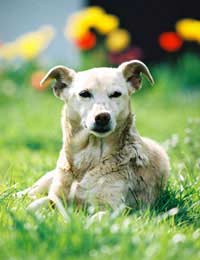
Even the smallest of garden centres will usually boast enough of a range of attractive plants to keep most gardeners happy, but unfortunately for homes with pets, sometimes even the most beautiful-looking flowers can hide a more dangerous side.
In nature, with so many different types of animals ready to make a meal of them, over the years plants have evolved a whole variety of defence mechanisms to avoid being eaten and while some went in for spikes and thorns, others developed poisons.
Although our modern cultivated plants have less need for these natural defences – after all, there aren’t too many grazing animals browsing through the average suburban garden – the bad news for our pets is that many garden favourites remain just as toxic as their wild ancestors. Pet-owning gardeners certainly need to keep their wits about them.
However, fortunately there are many good sources of help – including specialist books, online information, garden centres and your own vet – so with a little care and fore-thought it should be possible to enjoy gardening and make sure that your animals stay safe.
Poisonous to Cats and Dogs
The list of poisonous plants which pose a threat to cats and dogs is a long one and with new varieties making their way into our gardens and greenhouses every year, it is likely to continue to grow. However, amongst the most commonly encountered in British gardens are:
- Castor oil bush (Ricinus communis) – The seeds of the plant and the oil cakes often used as a fertiliser, are highly palatable to dogs, the poison “ricin” often proving fatal.
- Cherry laurel (Prunus laurocerasus) – A popular hedging plant, it can cause poisoning in dogs that eat or chew its leaves.
- Daffodil (Narcissus var.) – This popular spring-time bulb is potentially harmful to many small animals; the bulbs themselves are dangerous if eaten – even a small amount can be lethal – but all parts of the plant are poisonous and the PDSA warn that even the water from vases of cut daffodil flowers could be harmful.
- Laburnum (Cytisus alpines) – as the parents of small children are all too well aware, all of this magnificently showy tree is poisonous – but the seeds are especially so.
- Lilies (Lilium var.) – Many varieties of these beautiful flowers are dangerous to pets – especially cats – the leaves, stems, blooms and even pollen of some kinds being poisonous.
- Lily of the valley (Convallaria majalis) – the flowers and leaves of this old garden favourite can cause problems for both cats and dogs
- Yew (Taxus baccata) – often used to make hedges this is another well-known and highly toxic plant, potentially lethal to pet animals in very small amounts.
A number of other plants and houseplants are also potentially toxic to cats and dogs, including Azaleas, Dieffenbachia, foxgloves, some kinds of ivy, Philodendron and rhubarb.
Other Animals
It is not just dogs and cats that can suffer; animals which normally graze vegetation are obviously at particular risk from poisonous plants and, as horse owners have long been aware, there are a surprising number of them to contend with – including ragwort and bracken.
For the small animal owner, although it’s a great idea to let your rabbit or guinea pig enjoy the run of the garden, there are a few plants you really need to be aware of, to avoid heartache.
The list ranges from the commonplace buttercups (Ranunculaceae) and Box Privet (Buxusa sempervirens) to more unusual plants such as Water Hemlock– or Cowbane – (Cicuta virosa) an extremely poisonous plant, which can be fatal in a few hours. Whether your pet is big or small, if it naturally eats vegetation, it really does pay to know exactly what you have in your garden.
Calling the Vet
Obviously if you think you pet has eaten anything toxic, the first call should be to your vet – and without delay. The general symptoms to look out for include any obvious irritation to skin or mouth, vomiting, diarrhoea, excess salivation, rapid breathing, over-excitability or lethargy, excessive thirst, “shakes”, dizziness or disorientation.
Although some plants are extremely toxic to animals, it is important to remember that not all poisonings end in death – and timely veterinary intervention can often make the difference, so it pays to be vigilant.
For the pet-owning gardener, keeping companion animals safe does require a bit of thought and awareness, but it doesn’t need to spoil your enjoyment of either your garden or your pet. As with so many potentially harmful things in life, knowing the dangers is a big step towards avoiding them and – as the old proverb says – forewarned is forearmed.





do you know whether the product “flower magic” is pet freindly?
I have in my garden a mature Himalayan tree cotoneaster which produces large quantities of red berries each year. I now also have a Labrador pup which eats pretty much everything in sight. Are the tree berries poisonous to dogs!
There’s no agreement about whether cotoneaster berries are really poisonous or not. Eaten in quantities they are likely to causing an upset stomach and diarrhoea. Most dogs (even greedy labs) are quite good at recognising foods that aren’t good for them and cotoneaster berries don’t taste great which helps this.
We have a protection order on a yew tree in our garden, we have lived here for nearly a year, and seen a whole year of the effects the tree has It covers about a third of our small garden and overhangs into our neighbors garden It drops red berries everywhere which rot and leave seeds Over the years this has left a thick blanket of seeds in our garden which act as a banquet table for a family of rats, we have counted 2 adults and 6 babies last year They just sit and dig up the seeds and feast on them, they run around the rest of the garden where my young children want to play but I am reluctant to even let the kids out there with rat urine and faeces all over the place We have two guinea pigs which should be out in the garden but worry about them being poisoned by the yew berries or attacked by the rats Rats don’t seem to be adversely affected affected by the seeds or berries, in fact they thrive on them, Will the seeds and berries poison our guinea pigs?
You did know about the tree and the TPO when you purchased it (if you didn’t you should tackle your solicitor about this). Could you simply rake the berries (the seeds are enclosed in the berries on yew) and needles up regularly so the rats don’t have any food? Try talking to your Tree Preservation Officer, so see if they will allow you to do anything.